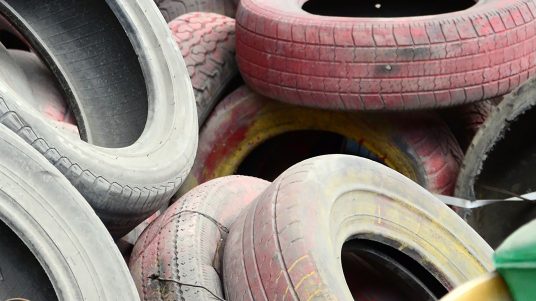Tires Discarded by the side of the road or Recycled and Re-purposed -Your choice
When they catch fire, all hell breaks loose. Tire fires are a notoriously nasty phenomenon. Once they begin, they’re tough to stop, and they release some of the most noxious toxins imaginable. The heat is tremendous, and tires begin melting into a sticky, burning-hot pool of oil—so firefighters can’t exactly approach on foot. Burning just one passenger car tire can produce two gallons of oil. That dark black plume of smoke contains some of the worst toxins imaginable for human health.
And yet, this remains a day to day occurrence in many places globally. However, the concept of sustainability has been gathering much-needed public attention and interest in recent years.
The increase of waste has serious environmental implications, and waste management must be carefully considered. There is now a focus on sustainable practices in almost all industries—including the rubber industry. The rubber industry has been faced with its own unique challenges when it comes to recycling.
There are over one billion end-of-life tires generated annually, worldwide. The South African tire industry produces around 10 million – 200 000 metric tons – of used tires each year. Less than 5% are recycled. An estimated 60 million old tires are today accumulating in the country’s landfills. They are often stored illegally or simply dumped somewhere. This unwanted waste represents a fire hazard and a considerable source of pollution because when it burns it emits toxic fumes. These tires are also a major threat to health since they help several species of mosquitoes to proliferate.
The problem with Tires
Discarded tires are an ideal breeding ground for mosquitoes and other disease-carrying animals because their hollow, rounded shape holds water for a long time. When disposed in a tire stockpile, used tires are often burned outdoors, which creates an ugly black smoke that contains toxic compounds (due in part to the oil and other products used in manufacturing tires).
Tires are also a problem in landfills: their hollow, rounded shape takes up valuable space in landfills. Additionally, tires often don’t stay buried. They have the unfortunate habit of trapping gases like methane and then “bubbling up” through landfills, ripping through landfill liners in the process.
Tires recycling and Re-purposing
Tire recycling is the process of converting end-of-life or unwanted old tires into material that can be utilized in new products. End-of-life tires typically become candidates for recycling when they become no longer functional due to wear or damage and can no longer be re-treaded or re-grooved.
The tire recycling process includes taking them apart and separating them into parts of different sizes, according to the designated use, while separating them from other parts that are found in the tire like iron and textile. At the end of the recycling process we get tiny pieces of rubber separately, textile pieces separately and iron separately, and we reuse all of them.
Today most of the recycled tires are used for building rubber fall surfacing in playgrounds, but recycled tires can also be found mixed with asphalt in roads, different tiles, safety products, as insulator materials in building and more.
Rubber recycling is synonymous with waste tire management for good reason. Old tires are by far the most common source of waste rubber.
Tire recycling and reuse have made great strides in recent years, partly due to environmental regulations and partly due to innovative technologies that have created new uses for old tires.
Civil engineers have found a wide variety of uses for old tires. Shredded tires are used in constructing road embankments and below-grade fill; they can also be used as a vibration-reducing material for railway lines. Ground-up tire rubber is also used as a road material or construction material when mixed with asphalt or concrete. Because of its shock-absorbing nature, shredded tires make an effective ground cover for safer playgrounds, and as a material for running tracks and other athletic facilities. And the durability of tires makes them ideal for reuse as dock bumpers, sidewalk material, roadway curbing and edging, even speed bumps and highway crash bumpers can be made of old tires.
Because oil and rubber burn well, shredded tires are burned as fuel in some industrial processes. Tire-derived fuel, or TDF, is used in pulp and paper factories, cement kilns, electric utilities, and other facilities. The question might be asked if the emissions from this type are also harmful but the research shows that if the facilities are operating properly then safety emission standards are able to be met for this type of fuel as well.
Benefits of tires recycling
Failure to recycle end-of-life tires is a missed opportunity to produce useful secondary raw material. In certain applications, ground rubber has unique properties that are superior to traditional materials.
Processing technology and manufacturing capacity have been in development for the better part of the last three decades with significant breakthroughs. Due to the effort, crumb rubber markets are steadily growing. The rise in popularity is partially driven by cost as recycled rubber is relatively inexpensive.
Closer:
Until recently, the technology and infrastructure to deal with this waste did not exist—rubber stockpiles were standard, despite the hazards. Fortunately, decades of concerted effort have culminated in effective rubber recycling programs. Old tires can find new life as playground surfaces, floor mats, or even impact-resistant parking stops.
The success of rubber recycling sheds light on a promising future in non-biodegradable waste management.

